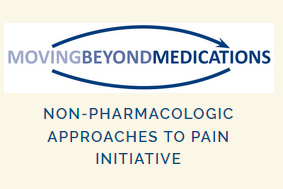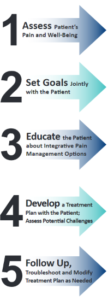Consortia seeks help disseminating pocket-guide on integrative pain options for conventional practitioners
October 10, 2017
 by John Weeks, Publisher/Editor of The Integrator Blog News and Reports The responses to the opioid crisis in the United States have been many. Yet, few have been as practical as the one four organizations that are the leading engines of change for integrative health in the United States recently collaborated to produce. The one-page pocket guide is titled “Moving Beyond Medications.” The resource’s target is conventionally practicing health professionals who may feel trapped in their prescribing of pharma. The one’s pager’s subtitle is: “Non-Pharmacological Approaches to Pain Management and Well-Being.” The goal is to get conventional practitioners to view non-pharmacologic, integrative strategies as “first-line” responses to pain. The educational resource can be useful as outreach for any member of the integrative health community. The developers are also urging individuals and organizations to disseminate it widely through their individual and organizational websites.
by John Weeks, Publisher/Editor of The Integrator Blog News and Reports The responses to the opioid crisis in the United States have been many. Yet, few have been as practical as the one four organizations that are the leading engines of change for integrative health in the United States recently collaborated to produce. The one-page pocket guide is titled “Moving Beyond Medications.” The resource’s target is conventionally practicing health professionals who may feel trapped in their prescribing of pharma. The one’s pager’s subtitle is: “Non-Pharmacological Approaches to Pain Management and Well-Being.” The goal is to get conventional practitioners to view non-pharmacologic, integrative strategies as “first-line” responses to pain. The educational resource can be useful as outreach for any member of the integrative health community. The developers are also urging individuals and organizations to disseminate it widely through their individual and organizational websites.  In an October 2, 2017 letter to members of ACIMH, chair Robert Saper, MD, MPH speak of the “new campaign launched to recommend non-pharmacological approaches as first-line pain treatment, with opioids considered only if these and non-opioid treatments are ineffective.” The one-pager outlines a 4-step plan: 1) Assess the Patient’s Pain and Well-being; 2) Set Goals Jointly with the Patients; 3) Educate the Patient about the Integrative Pain Management Options; 4) Develop a Treatment Plan with the Patient and Assess Potential Challenges; and 5) Follow-up: Troubleshoot and Modify Treatment Plan as Needed. Each of the steps is accompanied by 2-4 bullet points of guidance. The collaborators chose to position their document in alignment with recent Joint Commission guidelines and the Turn the Tide campaign to reduce opioid use of the former US Surgeon General. The document’s recommended approaches “include but not limited to” the following:
In an October 2, 2017 letter to members of ACIMH, chair Robert Saper, MD, MPH speak of the “new campaign launched to recommend non-pharmacological approaches as first-line pain treatment, with opioids considered only if these and non-opioid treatments are ineffective.” The one-pager outlines a 4-step plan: 1) Assess the Patient’s Pain and Well-being; 2) Set Goals Jointly with the Patients; 3) Educate the Patient about the Integrative Pain Management Options; 4) Develop a Treatment Plan with the Patient and Assess Potential Challenges; and 5) Follow-up: Troubleshoot and Modify Treatment Plan as Needed. Each of the steps is accompanied by 2-4 bullet points of guidance. The collaborators chose to position their document in alignment with recent Joint Commission guidelines and the Turn the Tide campaign to reduce opioid use of the former US Surgeon General. The document’s recommended approaches “include but not limited to” the following: - Acupuncture
- Chiropractic, Osteopathic and Myofascial Manipulation, Massage Therapy, and
- Physical Therapy
- Cognitive Behavioral Therapy, Stress Management, and other psychological therapies
- Mind-Body Approaches, Meditation, Biofeedback, Guided Imagery
- Yoga, Tai Chi, and other movement therapies




















SHARE